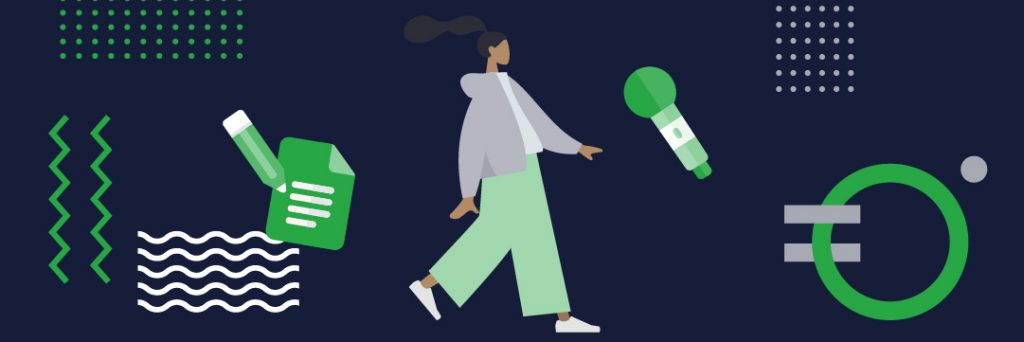So you have an interview audio file to transcribe? Where do you start? Why is transcribing interviews gaining so much traction?
Interviews are different because they involve dialogues and, therefore, will take more time to transcribe. Again, they are used for susceptible environments like recruitment and research. Moreover, the clients tend to demand the highest accuracy level, thus, translating to more time. The precision requirement usually beats the average 4:1 ratio for transcribing audio files.
When asked to transcribe an interview, it should not be a moment of panic. Hence, do not be scared by the sniffs, coughs, and parallel talking during interjection. All you need to know is that you are entering into another transcription realm that will challenge your skills: While at it, remember that interviews earn you more.
Once you master how to transcribe an interview, you might be among those earning a fortune.
Are you now interested in transcribing interviews?
Let’s continue.
How Are Interviews Different From Other Files?
For the avoidance of doubt, interview transcribers are among the best-paid transcriptionists in the market. It is their unique expectations that warrant higher pay.
Furthermore, the following features make interview transcription more expensive:
1. Dialogue
Interviews involve dialogues and conversations that bring together more than one person. The transcriber is expected to differentiate voices and allocate each participant a time stamp. Ultimately, it will be challenging if participants have similar vocal tones or no order in their speeches.
The best trick is to request the client to expand the brief to capture the participants in the interview. Remember, it will be easier if you know that there are two or three speakers. The ears can easily pick out their voices.
2. You Cannot Transcribe Using Automated Software
It takes a shorter time to transcribe an audio file using automatic software. However, the software works best with an audio file with one speaker. When two or more speakers engage the conversation, the automated software might struggle to identify multiple voices in an audio file. As a result, you will not get a complete interview transcript.
If you must use auto-transcription software, you end up with mixed-up words. You have the extra work of editing and assigning dialogues to individual speakers. While this reduces the time taken to complete an interview audio file, you have a lot more work to do to deliver a clean transcript.
3. Focuses More on Participants than Time Stamps
The basic training for a transcriber revolves around assigning timestamps to words, phrases, and sentences. Interview transcriptions, however, usually take a different perspective. The client is more interested in responses from interviewees and not the time stamp on the audio file.
Remember, the transcription brief captures the main point of interest for transcription clients. As such, you must pay more attention to such responses as opposed to timing for the dialogue.
4. Special Instructions
Interview transcription files come with special instructions depending on the intention of the interview. Therefore, clients are not just interested in verbatim transcription. In other cases, the resulting transcript has to take a different format based on the interview structure.
To meet the expectations of interview transcription, clients might require the transcriber to review the instructions. Hence, do not commence transcription until all instructions are clear. In case you do not understand the expectations, ask for a template or sample of the interview transcript.
Procedure to Follow When Transcribing Interviews
As you have already realized, you do not transcribe an interview like any other audio file. Once you pick the file, preparation is as necessary as the actual transcription. It will determine your experience.
Here is a simple procedure that should guide you when transcribing an interview:
i) Review the Audio File
Review the nature of the audio file to facilitate planning. How long is the file? Is the file clear? How many people are involved in the interview? How soon should the client expect the transcripts? Such analysis helps you to prepare as well as give real feedback to the clients.
Thus, review all instructions before accepting or starting on transcription: It is imperative when working as a freelancer because you negotiate the terms of the project.
Full knowledge of the project’s scope helps you charge the right amount that will guarantee value for money.
ii) Negotiate the Terms
Having understood what the project will take to complete, it is time to know how much you will earn. It is, therefore, vital when working with a freelancer.
Part of the discussion above makes it clear that interviews are difficult to transcribe. As such, the facts you establish when reviewing the file will help you to determine the best price.
Remember to consider the:
- length of the audio file
- number of speakers involved
- expectations from the client
- the urgency of the work
- High/low season for transcription work
As a transcriber or client, these are the factors that will determine how much you pay.
iii) Gather the Tools You Require
Transcription requires such tools as a computer gadget, headphones, and the right transcription software. The quality of your transcripts and the entire transcription experience depend on the tools available.
For instance, headphones with excellent sound quality make transcription faster by reducing cases of replay.
Hence, set the right transcription environment and allocate time to work on the audio files. You’ll avoid interruptions in the course of completing the project.
iv) Get Down To Work
Begin transcribing the audio files.
Having agreed on the submission timeline and the right tools at hand, work on the audio files as fast as possible.
Remember to manage the transcription environment so that it is efficient for your work.
v) Edit Your Transcripts
Editing is crucial both when transcribing manually and when using automated software. You’ll edit a transcript to eliminate grammatical errors while, at the same time, making the work coherent.
Editing makes your transcripts legible.
You will also eliminate the chaff found in conversations in the form of sniffs, bluff, and such unwarranted words.
Ultimately, a transcript should only capture the relevant information. Other activities in the background captured during verbatim transcription are thus, eliminated while editing.

How to Reduce the Time Taken when Transcribing Interviews
Efficiency during transcription determines your earnings. As such, it should take the shortest time possible to complete a transcription project.
However, note that the time taken to transcribe does not entirely depend on the audio file’s length. Other factors will slow down your transcription or enable you to work faster.
Here are a few hacks that will help you to transcribe faster and earn more.
a) Invest In High-Quality Transcription Tools
Transcription tools determine the quality of your work. A laptop or computer with a decent working speed means that your files load faster. Headphones that produce quality sound also reduce the need for playback, enhancing clarity when listening.
The best software will help do typing and replay easier, reducing the time taken to complete a project.
Since not every software is suitable for the job, choose the best software to make your work easier.
b) Choose A Quiet Place for Your Transcription Exercise
Transcription involves a lot of listening. As such, you do not want to hear voices that are not in your audio file or fail to get the right words because of background noise.
Choose a quiet place where the focus is purely on the audio file.
The best transcription environment is a quiet place. There should be no disruption in the form of unnecessary movements or interruptions around the transcription desk. The mind needs to focus on the audio file and not worry about people moving around.
c) Dedicate Sufficient Time for Transcription
Set a reasonable time to complete the transcription project. Transcription cannot be satisfactory when done in a hurry. You will often need to replay some sections to hear the words as said by the speaker.
Transcriptions done in a hurry are usually full of mistakes like wrong or missed words. Moreover, the transcript fails to make sense, causing conflicts with the client.
While you might not have the luxury of time, do not rush through a transcription project.
d) Run Through the Interview Several Times
Review the transcript several times before submission. It helps you to capture words and phrases you might have missed during the first run.
Running through the transcript is a form of editing. You end up with clear transcripts and will meet the expectations of your client.
Remember, the review should be carried out with the clients’ instructions by the side. Ensure that the transcript meets all conditions set by your client.
You’ll also avoid revisions that delay the completion of a project and cause conflict with clients.
The Best Transcribing Interviews Software
Your transcription experience will depend on the software you use. Luckily for transcribers, you have endless options when looking for transcription software. Interestingly, each software is designed to meet a particular purpose.
You can use any software to transcribe an interview.
But what makes the software suitable for interview transcription?
Here are a few tips.
· Easy To Use
Easy-to-use software makes transcription seamless. The features like play, pause, rewind, and skip, among others, are easily accessible.
Such software also comes with shortcuts such that you are not tied to the mouse pad or mouse. Above all, it should be easy to learn the software, even with continuous upgrades.
· Accuracy Assessment Reports
Each transcriber desires to improve on his performance continually.
With a better typing speed, more accuracy, and the ability to listen to longer bits, you will earn more.
The best software generates reports that you can use to improve your transcription skills.
· Cost of the Software
How much will you pay for the software?
A few transcription applications are free. In some cases, basic transcription features are free. However, you must buy the advanced features.
Therefore, the intensity and requirements of the project will determine whether to pay for the advanced features.
· Availability of Collaboration Tools
Transcripts arising from transcription projects are used on other platforms. As such, the software used must accommodate sharing of files. The same applies to audio files for transcription.
The software should also allow you to transfer or share files with other platforms freely. It saves you from converting the files every time you are moving or sharing them across applications.
The Bottom Line
Interviews require a different approach to transcribe. A lot of emphasis goes to the dialogues and not necessarily the timestamps.
As discussed above, automated transcription software will not help much in more than one voice. As such, most of the transcription is best done manually. Further, you have to edit the transcript to eliminate the chuff from coughs, sniffs, interruptions, and background noises.
Bunny Studio presents the best package when transcribing interviews. With highly trained, experienced, and passionate transcribers, you are sure that your transcripts will meet the highest standards.
Remember, Bunny Studio guarantees excellent value for money for your transcription projects.










